Well, 9 months later my installer and I got our schedules sorted out, and I no longer have a 5" uninsulated liner in my old brick flue, but a 6" insulated liner.
took some pics for those looking for a summer project
First - you can see how this is a real tight fit in the firebox. Screws are out waiting for removal.
Second - took out the mineral wool used as a "soft" block off plate. You an note the discoloration from the heat. Will be installing a steel plate vice reinstalling the mineral wool. Not to fond of the long term effects the heat may have on the mineral wool, given this is only after one season.
Third is a look down the flue - you can see the old tiles from the now removed oil furnace, and there is no liner tile at all on the fireplace side.
Forth is the installer cutting a larger hole in the cap my "mason" (used loosely) pour for me last year. Glad he didn't fall - not a recommended maneuver.
Fifth is the new 6" liner after we wrapped it and put the stainless wire mesh sock over it.
Last one is the old cap (new one is same style) I was glad to see little creosote build up overall - about a liter came out of the old liner after 2 1/2 cords of not dry enough wood, so I guess I'm doing something right as far as burns go.
Moral of the story - wish I had done this the first time, as opposed to finding out about the associated code issues for brick flues that have adjacent timbers - then I wouldn't have had to redo it. I let you know how the argument about the bill goes - I suspect the installer will want more money, but in all the discussion about geting the liner done right, the topic never came up - perhaps I won't get a bill, given he was the one who decided on what to install the first time.....
If you want the full details on the original install and how I learned I had a code problem you can read the post here-
https://www.hearth.com/econtent/index.php/forums/viewthread/23980/#257300
took some pics for those looking for a summer project
First - you can see how this is a real tight fit in the firebox. Screws are out waiting for removal.
Second - took out the mineral wool used as a "soft" block off plate. You an note the discoloration from the heat. Will be installing a steel plate vice reinstalling the mineral wool. Not to fond of the long term effects the heat may have on the mineral wool, given this is only after one season.
Third is a look down the flue - you can see the old tiles from the now removed oil furnace, and there is no liner tile at all on the fireplace side.
Forth is the installer cutting a larger hole in the cap my "mason" (used loosely) pour for me last year. Glad he didn't fall - not a recommended maneuver.
Fifth is the new 6" liner after we wrapped it and put the stainless wire mesh sock over it.
Last one is the old cap (new one is same style) I was glad to see little creosote build up overall - about a liter came out of the old liner after 2 1/2 cords of not dry enough wood, so I guess I'm doing something right as far as burns go.
Moral of the story - wish I had done this the first time, as opposed to finding out about the associated code issues for brick flues that have adjacent timbers - then I wouldn't have had to redo it. I let you know how the argument about the bill goes - I suspect the installer will want more money, but in all the discussion about geting the liner done right, the topic never came up - perhaps I won't get a bill, given he was the one who decided on what to install the first time.....
If you want the full details on the original install and how I learned I had a code problem you can read the post here-
https://www.hearth.com/econtent/index.php/forums/viewthread/23980/#257300
Attachments
-
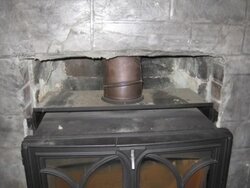 Chimney Liner reinstall (18).JPG22.3 KB · Views: 771
Chimney Liner reinstall (18).JPG22.3 KB · Views: 771 -
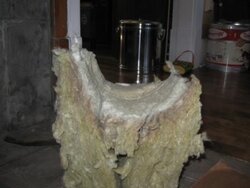 Chimney Liner reinstall (17).JPG19.2 KB · Views: 776
Chimney Liner reinstall (17).JPG19.2 KB · Views: 776 -
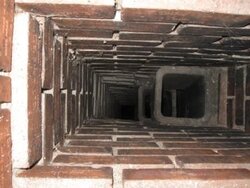 Chimney Liner reinstall (9).JPG28.9 KB · Views: 975
Chimney Liner reinstall (9).JPG28.9 KB · Views: 975 -
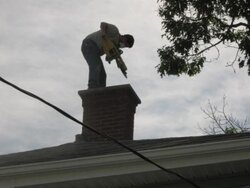 Chimney Liner reinstall (8).JPG19.6 KB · Views: 736
Chimney Liner reinstall (8).JPG19.6 KB · Views: 736 -
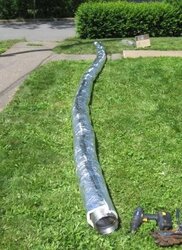 Chimney Liner reinstall (14).JPG45.9 KB · Views: 763
Chimney Liner reinstall (14).JPG45.9 KB · Views: 763 -
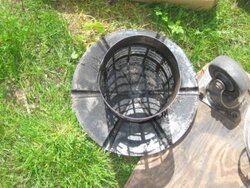 Chimney Liner reinstall (16).JPG42.7 KB · Views: 721
Chimney Liner reinstall (16).JPG42.7 KB · Views: 721


 ). There is little to no way to assure that the clearances are met in an existing brick chimney. As well, most of the labelling or instructions do, with enough review, cover thier butts with a comment on air space issues, but they rarely indicate insulation needs, or they may indicate insulation, but they don't indicate how to do it.
). There is little to no way to assure that the clearances are met in an existing brick chimney. As well, most of the labelling or instructions do, with enough review, cover thier butts with a comment on air space issues, but they rarely indicate insulation needs, or they may indicate insulation, but they don't indicate how to do it.